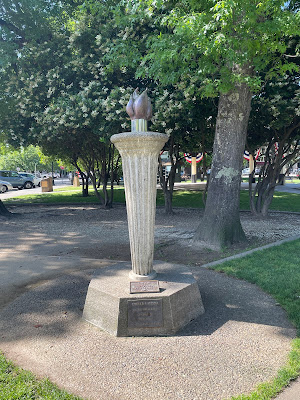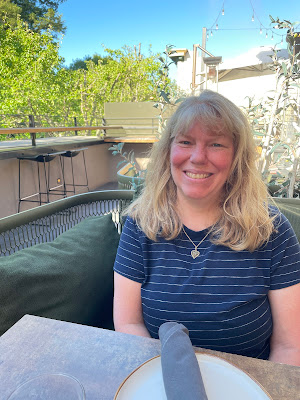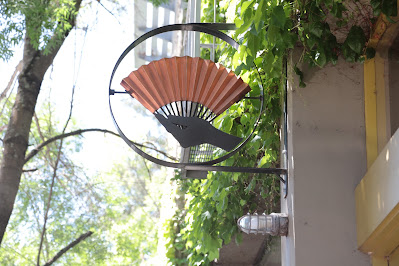Steve and I celebrated our 21st anniversary with a 2-night getaway to beautiful Healdsburg, California. Healdsburg is a charming small town of about 11,000 people, located in the Sonoma Valley, about an hour from where we live. It is packed with high-end restaurants, wineries, and art galleries.
Our 2nd floor room was spacious and luxurious. The balcony overlooked Healdsburg Plaza, the town square at the heart of Healdsburg.
Nature is everywhere around you at Hotel Healdsburg.
This was the 2nd floor atrium, located a few steps from our room.
We were greeted with a complimentary mocktail (because I can't have alcohol anymore due to
my cancer medication). The base of the mocktail was a
rhubarb shrub and absolutely delicious!
We had a canape of pork belly biscuits (amazing) and then ordered the three-course meal, with each of us opting for different items so we could try six different things instead of three. Everything was spectacular. The portion sizes were very generous - so much so that we each had to get most of our main course to go.
Not only did our desserts come with cute chocolate 'Happy Anniversary' signs, but they comped us a trio of extra desserts for us to try. I can't say enough good things about Dry Creek Kitchen. The food, the service, and the ambiance were all top-notch. It's a great place to go for a special occasion.
After a good night's sleep and an outstanding breakfast at the hotel, it was time to explore more of Healdsburg. We started in the Plaza. There are quite a few statues, artifacts, and memorials there, including a monument to
Healdsburg's four world champion athletes (page 14), a grist mill stone from a pioneer settler, a piece of beam from the World Trade Center, and a memorial to Healdsburg's fallen soldiers.
It's small, but worth a visit. And the price is right! (Free.) We both really enjoyed the exhibit about the Pomo Weavers Society.
Check out the tiny woven baskets attached to acorn caps!
I loved the beautiful quail bags.
We got a sneak peak of the upcoming exhibit, which looks interesting.
After the museum, we strolled through more of downtown Healdsburg. Hey, it's Good ol' Charlie Brown!
There are a handful of cute ice cream shops in Healdsburg. We couldn't resist and had outstanding sorbet from
Noble Folk. Definitely stop in.
Steve and I enjoyed the enormous chair.
Speaking of enormous, there was no way we were passing up the chance to see the largest moss wall in America.
The moss wall is located at
Paul Mahder Gallery, which itself is enormous. I've been to art museums with fewer pieces on display.
You have to go alllll the way to the back to get to the
moss wall. Sure enough - it's huge! It's really pretty and provides a nice setting to enjoy the art.
We had dinner at
Roof 106. It was perfect: a great setting, amazing food, and excellent service.
On our final day in Healdsburg, we had another delicious breakfast at the hotel. Then we visited more art galleries...
... and found some geocaches. It was difficult to be stealthy in such a pedestrian-friendly area, but we did our best.
Something we did not do in Healdsburg (besides wine tasting, spa treatments, and retail therapy)? We did not visit the
Hand Fan Museum. We'd planned to go, but the museum was not open during its posted hours; a scribbled sign in the window listed the very few hours a week they are now open. The website hasn't been updated, which is super annoying.
The closed museum was the only disappointment in Healdsburg; everything else exceeded our expectations. If you are looking for a pedestrian-friendly town with gourmet food, cute shops, upscale hotels, and a wonderful atmosphere, look no further than Healdsburg.







.jpg)
.png)







































.jpg)















